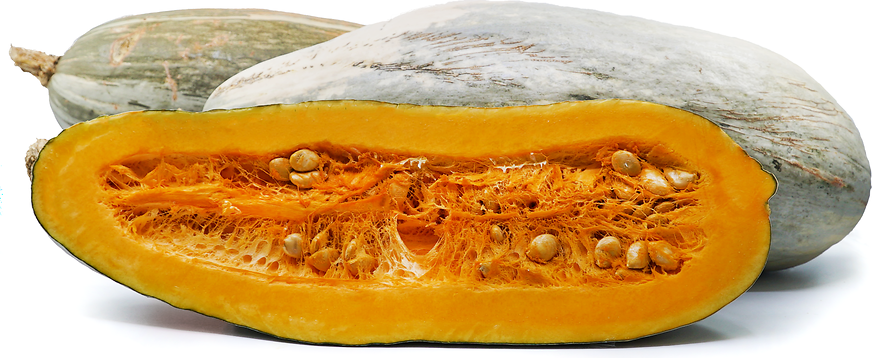


Guatemalan Blue Squash
Estimated Inventory, lb : 0
Description/Taste
Guatemalan Blue squashes are large, elongated fruits, averaging 35 to 40 centimeters in length and 6 to 10 pounds, and have an oblong to oval shape with slight tapering towards the curved ends. The rind is firm, hard, and smooth, ranging in color from dark green, green-blue, to a dusty, gray-green. There may also be some faint light green, vertical striping extending the length of the squash. Underneath the surface, the flesh is dense, thick, and dark orange, encasing a central, oval cavity filled with stringy fibers and many cream-colored seeds. Guatemalan Blue squashes have a smooth, tender texture when cooked and develop a sweet, nutty, and subtly fruity flavor.
Seasons/Availability
Guatemalan Blue squashes are available in the fall through winter.
Current Facts
Guatemalan Blue squashes, botanically classified as Cucurbita maxima, are a rare, heirloom variety belonging to the Cucurbitaceae family. The blue-gray squash is a type of banana squash, known for its large and elongated size, and is also called the Guatemalan Blue Banana squash in some regions of the United States. Guatemalan Blue squashes are native to Central and South America and have been grown for thousands of years as an indigenous variety. The squash was then introduced to the United States, where it saw initial success, but the variety was quickly overshadowed by more mainstream squashes such as the butternut. In the present-day, Guatemalan Blue squashes are not commercially cultivated due to their long, hot growing season requirements and are only found through select farms that focus on preserving unique varieties. Despite their rarity in commercial markets, Guatemalan Blue squashes are reemerging as a favored heirloom variety among home gardeners, valued for their extended storage capabilities, rapid growth, and high yields.
Nutritional Value
Guatemalan Blue squashes are a good source of vitamins A and C, which are antioxidants that strengthen the immune system while reducing inflammation. The squashes also contain fiber to stimulate digestion and provide lower amounts of iron and calcium.
Applications
Guatemalan Blue squashes are best suited for cooked applications, including roasting, frying, baking, simmering, and grilling. The soft, cooked flesh can be used in any recipe calling for banana squash and is frequently incorporated into curries, soups, and stews. Guatemalan Blue squashes can also be baked into gratins, cubed and roasted as a side dish, or halved and filled with grains, cheeses, and meats. In addition to savory applications, Guatemalan Blue squashes can be used to flavor pies, cakes, muffins, and bread, or cooked into jams and butter. Guatemalan Blue squashes pair well with spices such as nutmeg, cinnamon, cumin, ginger, and curry, herbs such as rosemary, thyme, and sage, meats such as poultry, fish, and pork, brown sugar, apples, raisins, cranberries, and nuts such as pecans, almonds, and walnuts. Whole squashes will keep up to one month when stored at room temperature and up to six months when kept in cold storage, such as a root cellar. Once the squash is cut, the remaining flesh can be wrapped in plastic and stored in the fridge for five days.
Ethnic/Cultural Info
The Mayan Empire was known for its sophisticated civilization, and during the height of the empire in the 6th century, an extensive agricultural system was also created that included raised crop beds, flooded fields, seasonal crop rotations, and growing multiple species together. One of the most famous systems developed from the Mayans was known as milpa, an intercropping technique used to grow staple vegetables in the Mayan diet. Milpa incorporates squash, beans, and corn in the same field to maximize space and promote growth. The corn was traditionally planted first as it was considered the most sacred crop, followed by the beans and squash. As the plants matured, the beans would climb up the corn stalks, helping to secure the corn from falling over, and the roots would emit nitrogen into the soil, replenishing nutrients. While the beans climbed vertically, the squash would expand and creep across the ground, helping to prevent soil erosion and to stop weeds from growing. The milpa system was considered so successful that it eventually spread to other civilizations throughout Central America, Mexico, and into the United States, where it is traditionally known as the three sisters planting system. Milpa-style gardens are still being used in Guatemala today, and many home gardeners also implement this system in their gardens to maximize space and increase yields.
Geography/History
Squashes belonging to the Cucurbita maxima species are native to South America, where they have been growing wild since ancient times. Many new varieties were created through extensive cultivation, and over time, the squashes were introduced into Central America through migrating peoples. The exact history of Guatemalan Blue squash is unknown, but the variety has been cultivated for over one thousand years and predates Columbus's arrival. Banana squashes were brought to the United States through R.H. Shumway in the 19th century. After the variety’s introduction, many seed catalogs also began advertising varieties of banana squashes, including the Guatemalan Blue for home gardening, but the variety eventually faded from popularity, becoming unknown. Today Guatemalan Blue squashes are considered to be a very rare variety that is only found through select growers, specialty grocers, and farmer’s markets in the United States. The variety is also grown on a small-scale in home gardens and small farms in Central, South, and North America.
Recipe Ideas
Recipes that include Guatemalan Blue Squash. One




